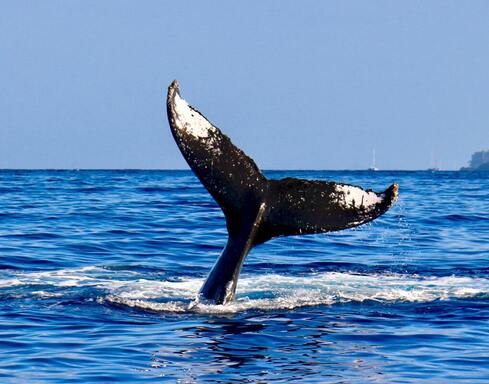|
You find yourself riding through the waves, when someone on the boat next to you points a direction on your right “A WHALE! There is a whale, on our right!”. You suddenly hear its blow, between the sounds of the sea and you can finally locate the animal position, resting on the surface of the water. You can see just a few details of its back, and yet you would like to know more about it. Would you be able to tell which species were you lucky enough to encounter? With this guide, we’ll try to give you all the necessary details to be able to differentiate baleen whales one from the other! Baleen whales in Tenerife Baleen whales count 16 different species of whales: the name comes from the baleen plates used to filter out food from the water when lunge-feeding or skim-feeding. Hereby we will list possible baleen whales sightings in Tenerife waters, and the features and characteristics that can help their identification when sighted: BLUE WHALE (Balaenoptera musculus) The blue whale is famous to hold the first position as the largest animal on the planet, reaching 33 meters in length and can weigh more than 160 tons. However, although the great size of the animal can aid in its identification, it can be easily confused with other whales that can reach huge lengths, such as the Fin Whale. The best clues for differentiating blue whales are indeed colour patterns, head shape and most easily its dorsal fin:
Fluking (showing the tail out of the water) is quite a common behaviour when the animal is diving, and their blow it’s tall, slender and can reach 9 meters high. Blue whales are a really rare sighting in Tenerife, but there is a higher chance to encounter them during winter months in the open sea. FIN WHALE (Balaenoptera physalus) This cetacean holds the second position as the largest animal on the planet, reaching 27 meters in length. It may be confused with other large balaenopterids, but there are indeed some distinctive characteristics:
They rarely show their flukes when diving but tend to be slightly more social than other rorquals, often gathering in pods of 2 to 7 whales. Their blow is thin and 4-6 meters high. They are easier to spot in the fall and winter months in Tenerife waters, yet it is quite an uncommon sighting, as they are a rather elusive species. SEI WHALE (Balaenoptera borealis) Features: Less large than the Fin Whale, the sei whale reaches about 16 meters in length. Their speed reaches 47 kilometers per hour, making them excellent swimmers and they have a slender and erect dorsal fin, a feature also shared by some Bryde’s whales species, which could make it difficult to recognize the species at distance. Usually the identification can be determined by:
Although it rarely shows the fluke when diving, experts distinguish it because it has a different dive sequence, more constant than other species. The sei whales are solitary although sometimes they have come to see large groups in abundant food banks. Sei whales are easier to spot in Tenerife during their migrating season, between fall and spring, and tend to reach the surface only briefly with 3 meters tall blows. BRYDE’s WHALE (Balaenoptera edeni) Bryde’s whale adults can be up to 15 meters long therefore they may be easily confused with sei whales. However, they present few features that may help the identification:
They usually do not show the fluke when diving and their blow can vary in dimension, as often they exhale underwater, then surface with little or no blow. It is not uncommon to see this species in Tenerife waters, yet it is usually migrating individuals all year long. HUMPBACK WHALE (Megaptera noveangliae) At close range, the humpback whale is one of the easiest whales to identify:
Humpback whales generally show their fluke when diving, and they can be individually identified due to distinctive bumps and markings on the undersides of their flukes. They general occur singly or in groups of 2 or three individuals when migrating, and their blow is rather low and bushy, reaching only 3 meters. MINKE WHALE (Balaenoptera acutorostrata) Minke whales are usually one of the easiest balaenoptera species to distinguish by their small size, as they can only reach 9 meters in length.
Minke whales usually do not fluke when diving, and their blows are usually diffuse and not visible at all at distance. It is quite a rare sighting in Tenerife waters. If you managed to encounter one of these giants during a sea-trip in Tenerife waters, it is very likely that it belongs to this list! Even the smallest details can be important when a whale is spotted!
Can you see its blow? How small is his dorsal fin? Can you spot the colours of its flippers? Did it fluke when diving? Find out about the best places to spot these giants and stay up to date on whale sightings following Atlantic Whale and Dolphin Foundation! Post by: Claudio Rotondi Sources Marine species identification portal, developed by ETI Informatics http://species-identification.org/index.php B.C. Cetacean Sightings Network, developed by Ocean Wise https://wildwhales.org/speciesid/ Marine Mammals of the World: A Comprehensive guide to their Identification, T.A Jefferson, Marc Webber, R.L Pitman https://www.sciencedirect.com/book/9780123838537/marine-mammals-of-the-world
1 Comment
|
AuthorsWe encourage all of our volunteers to submit a blog post, on any topic, whilst they are with us. Categories
All
Archives |







 RSS Feed
RSS Feed